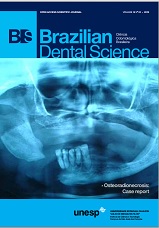Photographic assessment of hyperdivergent class II patients
DOI:
https://doi.org/10.14295/bds.2015.v18i2.1092Resumen
Temporomandibular disorders, sleep disturbances by airway obstruction and craniocervical posture changes constitute some of the problems that have been related to hyperdivergent class II patients. Although cephalometric radiographs represent the gold standard for diagnosing craniofacial morphology in clinical practice, it might not be feasible for large-scale epidemiological research. Objective: The aim of this study was to test the validity of a new photographic method in diagnosing hyperdivergent class II patients for epidemiological research purposes. Material and Methods: Lateral cephalograms and profile photographs were obtained from 123 subjects assigned into two groups. 51 patients comprised the hyperdivergent class II group and the other 72 composed a second group. Discriminant analysis described a mathematical model to better diagnose hyperdivergent class II patients through photographs. Results: A canonical discriminant function composed of two photographic variables correctly classified 85% of the hyperdivergent class II patients during internal validation (p < 0.001). The method showed 83% sensitivity and 73% specificity in external validation procedure. Conclusion: The photographic method may be a feasible and practical alternative for diagnosing the hyperdivergent class II patient, particularly if there is a need for a low-cost and noninvasive method.
Descargas
Descargas
Publicado
Cómo citar
Número
Sección
Licencia
Brazilian Dental Science uses the Creative Commons (CC-BY 4.0) license, thus preserving the integrity of articles in an open access environment. The journal allows the author to retain publishing rights without restrictions.
=================
COPYRIGHT TRANSFER AND RESPONSIBILITY STATEMENT
(PDF)
For all articles published in the BDS journal, copyright is retained by the authors. Articles are licensed under an open-access Creative Commons CC BY 4.0 license, meaning that anyone may download and read the paper for free. In addition, the article may be reused and quoted, provided that the original published version is cited. These conditions allow for maximum use and exposure of the work while ensuring that the authors receive proper credit. All metadata associated with published articles is released under the Creative Commons CC0 Universal Public Domain Dedication.
Before the submission, authors must obtain permission to reproduce any published material (figures, schemes, tables, or any extract of a text) that does not fall into the public domain or for which they do not hold the copyright. Permission should be requested by the authors from the copyright holder (usually the Publisher, please refer to the imprint of the individual publications to identify the copyright holder).
The authors hereby attest that the study is original and does not present manipulated data, fraud, or plagiarism. All names listed made a significant scientific contribution to the study, are aware of the presented data, and agree with the final version of the manuscript. They assume complete responsibility for the ethical aspects of the study.
This text must be printed and signed by all authors. The scanned version should be submitted as supplemental file during the submission process.




























